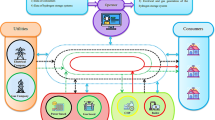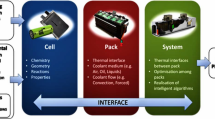Abstract
Combined cooling, heating and power (CCHP) systems have been considered as a potential energy saving technology for buildings due to their high energy efficiency and low carbon emission. Thermal energy storage (TES) can improve the energy efficiency of CCHP systems, since they reduce the mismatch between the energy supply and demand. However, it also increases the complexity of operation optimization of CCHP systems. In this study, a multi-agent system (MAS)-based optimal control method is proposed to minimize the operation cost of CCHP systems combined with TES. Four types of agents, i.e., coordinator agents, building agents, energy management agents and optimization agents, are implemented in the MAS to cooperate with each other. The operation optimization problem is solved by the genetic algorithm. A simulated system is utilized to validate the performance of the proposed method. Results show that the operation cost reductions of 10.0% on a typical summer day and 7.7% on a typical spring day are achieved compared with a rule-based control method. A sensitivity analysis is further performed and results show that the optimal operation cost does not change obviously when the rated capacity of TES exceeds a threshold.
Similar content being viewed by others
References
Ahmad MW, Mourshed M, Yuce B, et al. (2016). Computational intelligence techniques for HVAC systems: A review. Building Simulation, 9: 359–398.
Anvari-Moghaddam A, Rahimi-Kian A, Mirian MS, et al. (2017). A multi-agent based energy management solution for integrated buildings and microgrid system. Applied Energy, 203: 41–56.
ASHRAE (2007). Energy standard for buildings except low-rise residential buildings. Atlanta, GA, USA: American Society of Heating, Refrigerating and Air-Conditioning Engineers.
Bellifemine F, Poggi A, Rimassa G (1999). JADE—A FIPA-compliant agent framework. In: Proceedings of PAAM, London, UK.
Bünning F, Sangi R, Müller D (2017). A Modelica library for the agent-based control of building energy systems. Applied Energy, 193: 52–59.
Cai J, Braun JE, Kim D, et al. (2016). General approaches for determining the savings potential of optimal control for cooling in commercial buildings having both energy and demand charges. Science and Technology for the Built Environment, 22: 733–750.
Deng N, Cai R, Gao Y, et al. (2017). A MINLP model of optimal scheduling for a district heating and cooling system: a case study of an energy station in Tianjin. Energy, 141: 1750–1763.
GB 50189-2005 (2005). Design Standard for Energy Efficiency of Public Buildings. Ministry of Construction of China. (in Chinese)
González-Briones A, de la Prieta F, Mohamad M, et al. (2018). Multi-agent systems applications in energy optimization problems: a state-of-the-art review. Energies, 11(8): 1928.
Gu Q, Ren H, Gao W, et al. (2012). Integrated assessment of combined cooling heating and power systems under different design and management options for residential buildings in Shanghai. Energy and Buildings, 51: 143–152.
Holland J (1992). Adaptation in Natural and Artificial Systems. Cambridge, MA, USA: MIT Press.
Klein L, Kwak JY, Kavulya G, et al. (2012). Coordinating occupant behavior for building energy and comfort management using multi-agent systems. Automation in Construction, 22: 525–536.
Klein SA, Beckman WA, Mitchell JW, et al. (2004a). TRNSYS 16—A TRaNsient SYstem Simulation program, User manual. Solar Energy Laboratory, University of Wisconsin-Madison, USA.
Klein SA, Beckman WA, Mitchell JW, et al. (2004b). TRNSYS 16—Volume 6, Multizone Building Modeling with Type 56 and Trnbuild. Solar Energy Laboratory, University of Wisconsin-Madison, USA.
Lavinal E, Weiss G (1999). Multiagent Systems: A Modern Approach to Distributed Artificial Intelligence. Cambridge, MA, USA: MIT Press.
Li F, Sun B, Zhang C, et al. (2019). A hybrid optimization-based scheduling strategy for combined cooling, heating, and power system with thermal energy storage. Energy, 188: 115948.
Li C, Jia X, Zhou Y, et al. (2020). A microgrids energy management model based on multi-agent system using adaptive weight and chaotic search particle swarm optimization considering demand response. Journal of Cleaner Production, 262: 121247.
Liu M, Shi Y, Fang F (2012). A new operation strategy for CCHP systems with hybrid chillers. Applied Energy, 95: 164–173.
Liu W, Chen G, Yan B, et al. (2015). Hourly operation strategy of a CCHP system with GSHP and thermal energy storage (TES) under variable loads: A case study. Energy and Buildings, 93: 143–153.
Lizana J, Chacartegui R, Barrios-Padura A, et al. (2018). Advanced low-carbon energy measures based on thermal energy storage in buildings: A review. Renewable and Sustainable Energy Reviews, 82: 3705–3749.
Lu Y, Wang S, Sun Y, Yan C (2015). Optimal scheduling of buildings with energy generation and thermal energy storage under dynamic electricity pricing using mixed-integer nonlinear programming. Applied Energy, 147: 49–58.
Luo XJ, Fong KF (2017). Development of multi-supply-multi-demand control strategy for combined cooling, heating and power system primed with solid oxide fuel cell-gas turbine. Energy Conversion and Management, 154: 538–561.
Luo XJ, Fong KF (2019). Development of integrated demand and supply side management strategy of multi-energy system for residential building application. Applied Energy, 242: 570–587.
MacNaughton P, Cao X, Buonocore J, et al. (2018). Energy savings, emission reductions, and health co-benefits of the green building movement. Journal of Exposure Science & Environmental Epidemiology, 28: 307–318.
Mago PJ, Hueffed AK (2010). Evaluation of a turbine driven CCHP system for large office buildings under different operating strategies. Energy and Buildings, 42: 1628–1636.
Mago PJ, Smith AD (2012). Evaluation of the potential emissions reductions from the use of CHP systems in different commercial buildings. Building and Environment, 53: 74–82.
Mancarella P, Chicco G (2008). Assessment of the greenhouse gas emissions from cogeneration and trigeneration systems. Part II: Analysis techniques and application cases. Energy, 33: 418–430.
Mao M, Jin P, Hatziargyriou ND, et al. (2014). Multiagent-based hybrid energy management system for microgrids. IEEE Transactions on Sustainable Energy, 5: 938–946.
MathWorks (2015). Matlab/Simulink Documentation. Available at http://www.mathworks.com/. Accessed 30 Nov 2020.
Minciuc E, Le Corre O, Athanasovici V, et al. (2003). Fuel savings and CO2 emissions for tri-generation systems. Applied Thermal Engineering, 23: 1333–1346.
Onishi VC, Antunes CH, Fraga ES, et al. (2019). Stochastic optimization of trigeneration systems for decision-making under long-term uncertainty in energy demands and prices. Energy, 175: 781–797.
Pertzborn A (2019). Using distributed agents to optimize thermal energy storage. Journal of Energy Storage, 23: 89–97.
Rajaeifar MA, Ghobadian B, Safa M, et al. (2014). Energy life-cycle assessment and CO2 emissions analysis of soybean-based biodiesel: A case study. Journal of Cleaner Production, 66: 233–241.
Soetedjo A, Nakhoda YI, Saleh C (2019). An embedded platform for testbed implementation of multi-agent system in building energy management system. Energies, 12: 3655.
Song Z, Liu T, Liu Y, et al. (2020). Study on the optimization and sensitivity analysis of CCHP systems for industrial park facilities. International Journal of Electrical Power and Energy Systems, 120: 105984.
Su F, Huang J, Xu T, et al. (2009). An evaluation of the effects of various parameter weights on typical meteorological years used for building energy simulation. Building Simulation, 2: 19–28.
Su B, Wang S (2020). An agent-based distributed real-time optimal control strategy for building HVAC systems for applications in the context of future IoT-based smart sensor networks. Applied Energy, 274: 115322.
Wang J, Jing Y, Zhang C, et al. (2011). Performance comparison of combined cooling heating and power system in different operation modes. Applied Energy, 88: 4621–4631.
Wang J, Sui J, Jin H (2015). An improved operation strategy of combined cooling heating and power system following electrical load. Energy, 85: 654–666.
Wu J, Wang J, Li S (2012). Multi-objective optimal operation strategy study of micro-CCHP system. Energy, 48: 472–483.
Yang R, Wang L (2013a). Development of multi-agent system for building energy and comfort management based on occupant behaviors. Energy and Buildings, 56: 1–7.
Yang R, Wang L (2013b). Multi-zone building energy management using intelligent control and optimization. Sustainable Cities and Society, 6: 16–21.
Zhao Y, Lu Y, Yan C, et al. (2015). MPC-based optimal scheduling of grid-connected low energy buildings with thermal energy storages. Energy and Buildings, 86: 415–426.
Zhu G, Chow TT, Fong KF, et al. (2018). Design optimisation and performance appraisal of a combined cooling, heating and power system primed with Maisotsenko combustion turbine cycle. Energy Conversion and Management, 177: 91–106.
Zhu G, Chow TT (2019). Design optimization and two-stage control strategy on combined cooling, heating and power system. Energy Conversion and Management, 199: 111869.
Acknowledgements
The project was supported by the State Key Laboratory of Air-Conditioning Equipment and System Energy Conservation (No. ACSKL2019KT07) and the National Natural Science Foundation of China (No. 51706197).
Author information
Authors and Affiliations
Corresponding author
Rights and permissions
About this article
Cite this article
Wang, Z., Zhang, C., Li, H. et al. A multi agent-based optimal control method for combined cooling and power systems with thermal energy storage. Build. Simul. 14, 1709–1723 (2021). https://doi.org/10.1007/s12273-021-0768-9
Received:
Revised:
Accepted:
Published:
Issue Date:
DOI: https://doi.org/10.1007/s12273-021-0768-9




